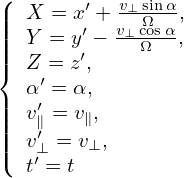
Denote the distribution function expressed in terms of the guiding-center variables (X,𝜀,μ,α) by fg. Then
 | (15) |
where the value of (x,v) is obtained by the inverse guiding-center transform. Equation (15) along the inverse guiding-center transform can be considered as the definition of fg.
As is conventionally adopted in multi-variables calculus, both fp and fg are sometimes simply denoted by f. Which one is actually assumed depends on the context, i.e., depends on which independent variables are actually assumed: particle variables or guiding-center variables. This is one of the subtle (trivial) things needed to be noted for gyrokinetic theory in particular and for multi-variables calculus in general. It seems better to use subscript notation on f to identify which coordinates are assumed. One example where this distinguishing is important is encountered when we try to express the diamagnetic flow in terms of fg, which is discussed in Appendix C.
In practice, fg is often called the guiding-center distribution function whereas fp is called the particle distribution function. However, they are actually the same distribution function expressed in different variables. The name “guiding-center distribution function” is misleading because it may imply that we can count the number of guiding-centers to obtain this distribution function but this implication is wrong.